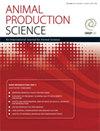Phenotypic variation in residual feed intake and relationship with body composition traits and methane emissions in growing wether lambs
IF 1.2
4区 农林科学
Q2 Agricultural and Biological Sciences
引用次数: 0
Abstract
Context Ruminant livestock industries are seeking to improve efficiency of feed use and reduce greenhouse gas emissions.Aims The research aimed to measure variation in feed intake and residual feed intake (RFI) in growing lambs and examine the inter-relationships of related traits and diet effects.Methods In Phase 1, 6-month-old Merino wethers (n=113) were fed a base diet ad libitum for 60days to measure dry matter intake (DMI), liveweight (LWT) and average daily gain (ADG). Whilst being fed the same base diet, measures of body composition (using computer tomography scanning) and methane emissions were collected. For Phase 2, lambs selected for low or high RFI in Phase 1 were randomly assigned to either a low or high diet and fed ad libitum for 30days. They were assessed for intake, growth, body composition and CH4 emissions.Key results In Phase 1 there was significant variation in DMI, which was explained by these traits in order of significance (R2 additive): LWT (R2=63.9%), ADG (R2=70.4%) and fat gain (R2=75.7%). In Phase 2, high RFI lambs had higher metabolisable energy intake (MEI; P<0.05) compared to low RFI lambs. In lambs fed the high diet, intake (DMI and MEI P<0.001), LWT (P<0.05), ADG (P<0.001), fat and lean gain (P<0.001) were higher than in lambs fed the low diet. Daily methane emissions were highest (P<0.05) in high RFI lambs fed the high diet. There were no significant effects of RFI or diet on methane yield (MY; g methane/kgDM). Differences in RFI or RFI adjusted for fat gain did not persist to the end of the 30day feeding period in Phase 2.Conclusions Lambs with low RFI had lower MEI for the same liveweight as well as lower fat and lean gain in the empty bodyweight. They also had lower daily methane emissions compared to those that had high RFI and ate more.Implications The opportunity to select sheep at a young age with lower RFI and lower MEI is of significant production and environmental importance.生长羔羊剩余采食量的表型变异及其与体成分性状和甲烷排放的关系
反刍畜牧业正在寻求提高饲料使用效率和减少温室气体排放。目的测定生长羔羊采食量和剩余采食量(RFI)的变化,探讨相关性状与日粮效应的相互关系。方法在第一阶段试验中,选用6月龄美利奴羊113头,饲喂基础饲粮60d,测定干物质采食量(DMI)、活重(LWT)和平均日增重(ADG)。在饲喂相同基础饲料的同时,收集了身体成分(使用计算机断层扫描)和甲烷排放量的测量数据。在第二阶段,在第一阶段选择低RFI或高RFI的羔羊,随机分配低或高饲粮,自由饲喂30天。评估了它们的摄入量、生长、身体成分和甲烷排放量。1期DMI有显著性变化,各性状的显著性排序为:LWT (R2=63.9%)、ADG (R2=70.4%)、脂肪增重(R2=75.7%)。在第二阶段,高RFI羔羊有更高的代谢能摄入量(MEI;P<0.05)。高饲粮羔羊的采食量(DMI和MEI P<0.001)、LWT (P<0.05)、平均日增重(P<0.001)、脂肪和瘦肉增重(P<0.001)均高于低饲粮羔羊。高RFI羔羊日甲烷排放量最高(P<0.05)。RFI和日粮对甲烷产量(MY;g甲烷/ kgDM)。在第2阶段的30天饲喂期结束时,RFI或经脂肪增加调整后的RFI的差异并未持续。结论低RFI的羔羊在相同的活重下具有较低的MEI值,空体重中脂肪和瘦肉增重较低。与那些高RFI和吃得更多的人相比,他们的每日甲烷排放量也更低。在较低RFI和较低MEI的幼龄羔羊中选择机会具有重要的生产和环境意义。
本文章由计算机程序翻译,如有差异,请以英文原文为准。
求助全文
约1分钟内获得全文
求助全文
来源期刊

Animal Production Science
Agricultural and Biological Sciences-Food Science
CiteScore
3.00
自引率
7.10%
发文量
139
审稿时长
3-8 weeks
期刊介绍:
Research papers in Animal Production Science focus on improving livestock and food production, and on the social and economic issues that influence primary producers. The journal (formerly known as Australian Journal of Experimental Agriculture) is predominantly concerned with domesticated animals (beef cattle, dairy cows, sheep, pigs, goats and poultry); however, contributions on horses and wild animals may be published where relevant.
Animal Production Science is published with the endorsement of the Commonwealth Scientific and Industrial Research Organisation (CSIRO) and the Australian Academy of Science.
 求助内容:
求助内容: 应助结果提醒方式:
应助结果提醒方式:


